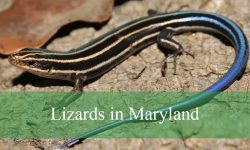If you have a backyard garden, chances are you’ve come across several horned caterpillars. These creepy crawlies with horns are larvae of moths and butterflies. They use their horns to defend themselves against potential predators.
Identifying different types of horned caterpillars can sound simple, but you need to know a thing or two. Some hornworms have a horn-like tail, and others have spiky-looking structures to give them a caterpillar appearance.
We wrote this article to share detailed information about various horned caterpillar types with pictures for easy identification. Examples of horned caterpillars are dragon-headed caterpillars, tomato hornworms, tobacco hornworms, and more.
Are Horned Caterpillars Poisonous?
The posterior horns on caterpillars are decorations and not used for stinging potential predators. These horns are flexible and sometimes brightly colored though depending on the caterpillar species.
Horned caterpillars are not poisonous when touched. But these insect crawlies can cause stomach upset when ingested in large quantities. We recommend learning the toxicity level of each caterpillar species before handling it.
The old Native American tribe in Arizona had the skills to sample edible caterpillars many years ago. Studies show that caterpillars have more nutritional value to humans than fast foods in restaurants. (Source: University of Michigan).
The horns might make these caterpillars look scary, but there is no need to freak if you stumble upon them in your garden. We recommend using protective gear and insecticides to get rid of them since they are destructive.
Horned caterpillars munch leaves of trees, shrubs, and ornamental or edible plants in your garden. These destructive creatures will turn into pupa and later moths or butterflies after some time.
Butterflies and moths are excellent pollinators of garden plants during the summer and spring seasons. They are harmless and non-destructive like their larvae counterparts.
Different Types of Horned Caterpillars with Pictures
Horned caterpillars are the scariest creepy crawlies to humans. These unwanted visitors usually munch on the leaves of trees, shrubs, and ornamental and edible plants in your backyard garden. Here is a list of caterpillars with horns for easy identification.
Monarch Caterpillar
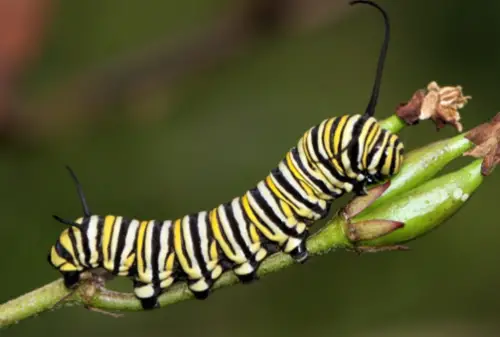
It is a unique type of horned caterpillar due to the horns on either side of its body. The head has longer antennae than the tail.
A juvenile monarch butterfly caterpillar looks different from its mature counterpart since body color and appearance change at different growth stages.
A mature larva has black, white, and yellow striped patterns on its body. These butterfly caterpillars are harmless and do not sting human beings or pets.
After pupation, these grubs turn into the most beautiful butterflies in the world. Most monarch butterflies are seen from late April to early June.
Scientific Name |
Danaus plexippu |
Host Plants |
Milkweed plants |
Identification Features |
Black, white, and yellow striped markings wrap around each segment. |
Tomato Hornworm
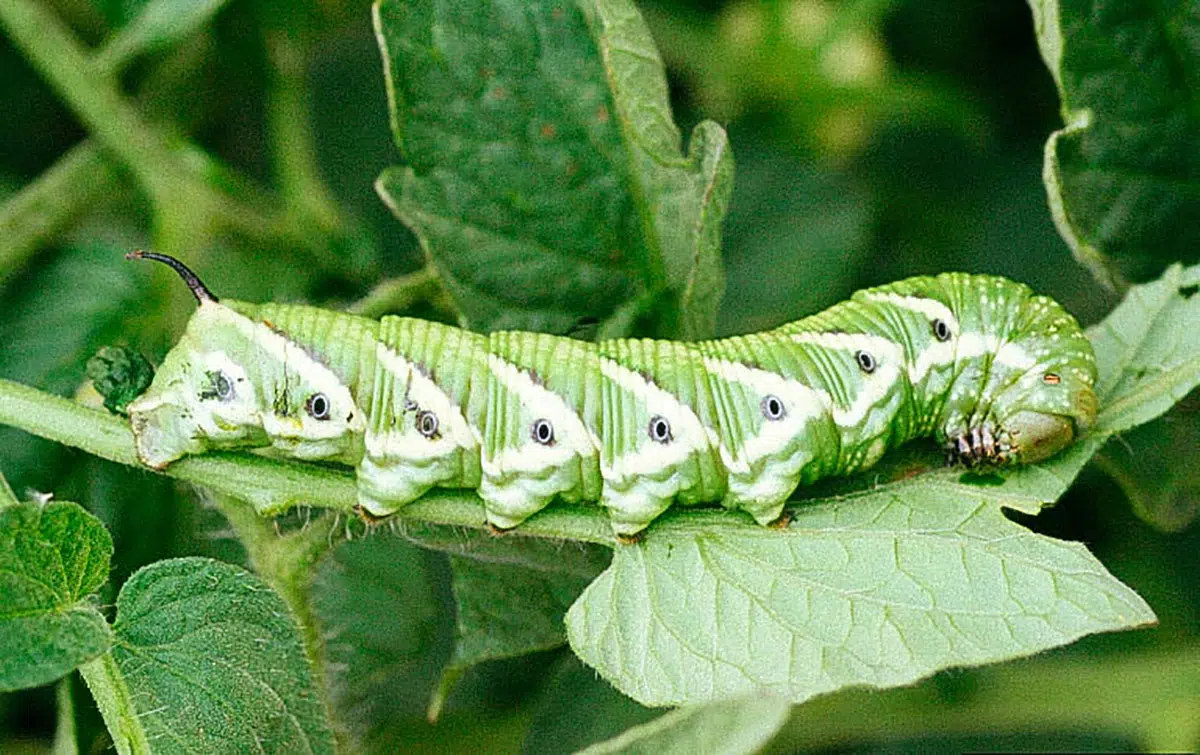
It is another type of green caterpillar with a horned tail. The large lime-green larva loves feeding on the leaves of tomatoes.
Spotting these grubs on the tomato leaves can be challenging due to their colors. The huge or oversized head can help identify and classify tomato hornworms.
The cream-colored markings along the sides and eye-like markings on the ends help confuse potential predators. The species is the largest caterpillar in the garden.
We recommend picking them physically from the tomato leaves to control their population. These caterpillars are non-poisonous and their horns do not sting.
Scientific Name |
Manduca quinquemaculata |
Host Plants |
Tomato plants |
Identification Features |
Fat slug-like caterpillar with protruding horns on the rear end. |
Tobacco Hornworm
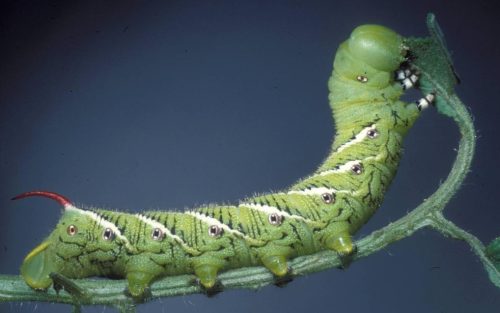
The single pointed horn-like tail is the distinctive feature for identifying and classifying tobacco hornworms. These grubs have green luminous bodies with oversized heads.
The plump segmented bodies and eye-like markings along the sides are other features for easy recognition. But it can be challenging to distinguish the head from the tail.
These annoying garden pests love feeding on the leaves of tomato plants and eggplants. The thin diagonal stripes on each segment differentiate them from the tomato hornworms.
Scientific Name |
Manduca sexta |
Host Plants |
Tomato plants and eggplants |
Identification Features |
Thin diagonal stripes on each segment with a single pointed horn-like tail. |
Hickory Horned Devil
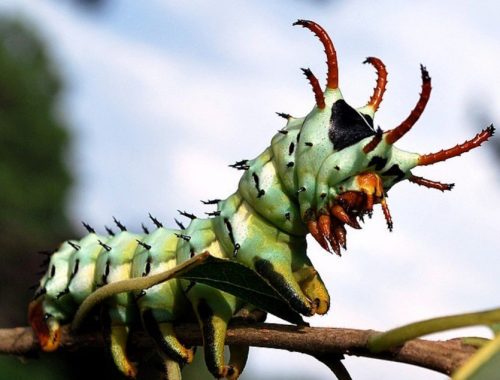
These caterpillars have a scary appearance to intimidate potential predators. They have turquoise-green bodies with large red jagged curved horns on their head.
Besides that, hickory horned devil caterpillars have other small black horns on each segment. They can grow up to 16cm long and appear as dangerous caterpillars.
These caterpillars are placid and harmless to humans or pets. These garden pests feed on the foliage of the hickory, cotton, and hazel trees.
Hickory-horned devil larvae turn into a regal moth with orange wings and red-striped markings. The patches of white dots on the wings make these moths prettier.
Scientific Name |
Citheronia regalis |
Host Plants |
Hickories, cotton, and hazel |
Identification Features |
Fat slug-like caterpillar with turquoise-green body and large red horns on the head. Smaller black horns appear on each segment |
Rose Maple Caterpillar
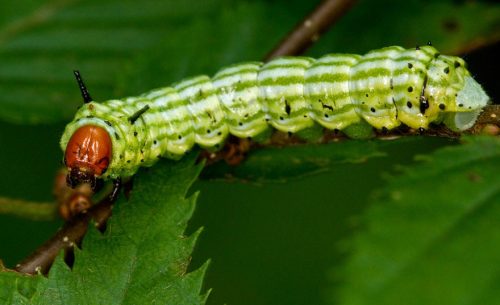
It is a type of striped caterpillar that dwells on maple trees. These crawling insects are also called green-striped mapleworms.
The two jet-black horns on the head are the distinctive features for identifying and classifying this striped caterpillar.
The fat slug-like caterpillar has greenish-white stripes running lengthwise and keeps changing its body color at each growth stage.
You can also use the black spots running around its body to identify rose maple caterpillars. They are harmless since they do not sting when handled.
Scientific Name |
Dryocampa rubicunda |
Host Plants |
|
Identification Features |
Light green and striped body with two jet black horns on the head. |
Rustic Sphinx Caterpillar
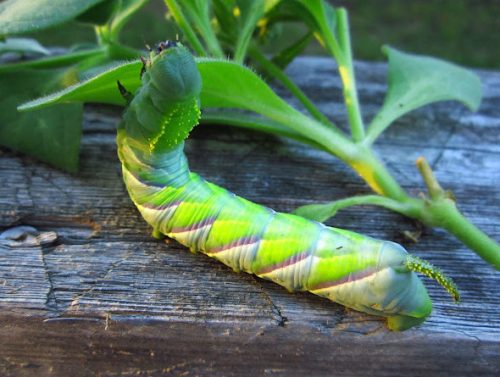
The species has a long sharp-looking dark greenhorn on its tail. The caterpillar is closely related to hornworms and other sphinx caterpillars.
Rustic sphinx caterpillars have bright green bodies with visible segments separated by diagonal light-colored lines.
The small orange-red dots on the sides of each segment and the black dots between the segments are other distinctive features for identification.
Scientific Name |
Manduca rustica |
Host Plants |
American beautyberry, ash, butterfly bush, and crape myrtle. |
Identification Features |
Bright green caterpillar with granular bumps on the rear horn. |
White Admiral Caterpillar
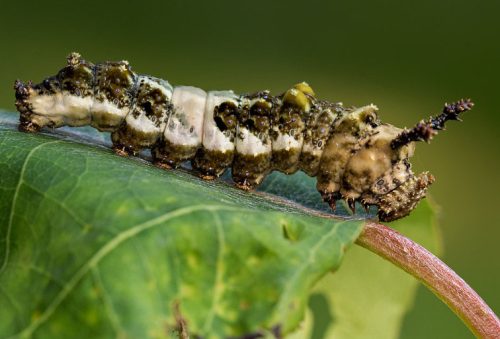
The species is native to North America and has an unusual appearance. The two long spiky black horns appear on one end of the body.
The brown and white patches are unique features for identifying white admiral caterpillars from others. They look like bird droppings to disguise themselves on the tree branches.
These larvae love feeding on the leaves of the willows, birches, cherries, hickories, and aspen trees. They turn into blue iridescent butterflies after pupation.
Scientific Name |
Limenitis arthemis |
Host Plants |
Willow, cherry, birch, and aspen trees |
Identification Features |
The unusual appearance of olive-brown and white patchy markings with two twig-like horns. |
Orange Striped Oakworm
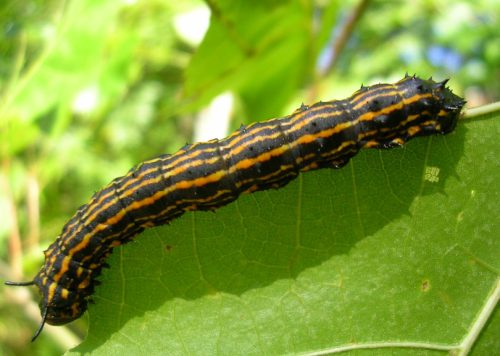
It is a striped black caterpillar with horns and tiny spikes around its body. The caterpillar looks like a large long slug with orange stripes running lengthwise.
These caterpillars are harmless despite having two horns at the head. The tiny spikes do not sting humans or pets.
Orange-striped oakkworms feed on the foliage of all types of oak trees. These long slug-like caterpillars are native to Florida, Texas, and other southern states.
These striped oakworms turn into beautiful orange and pink moths. We recommend using chemical treatments to eliminate these grubs from your ornamental oak trees.
Scientific Name |
Anisota senatoria |
Host Plants |
All types of oak trees |
Identification Features |
Orange stripes, long antennae, and spiky rear end. |
Dragon-Headed Caterpillar
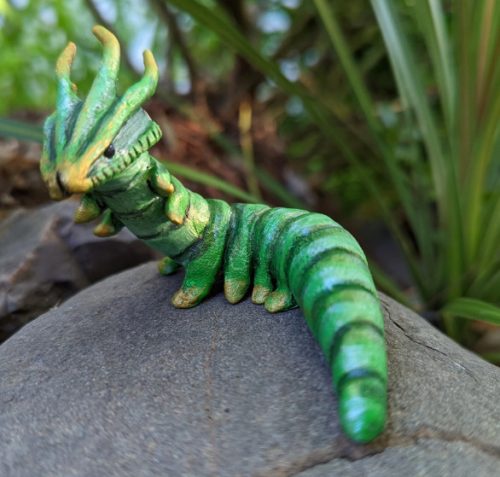
It is a long green slug-like caterpillar with four long curled horns on its head. The caterpillar has a dragon-like head with horns that give it a menacing appearance.
Dragon-headed caterpillars are harmless and do not sting. These caterpillars hail from Indonesia and central Asia.
Dragon-headed caterpillars turn into beautiful butterflies with chocolate brown wings and yellow or cream markings on them.
Scientific Name |
Polyura athamas |
Host Plants |
All garden crops and trees |
Identification Features |
Dark green caterpillar with two horns on either side of its head and lateral creamy white stripes on its middle segments. |
Blue Swallowtail Caterpillar

It is a swallowtail species with several horns that create a menacing appearance. The blue swallowtail also called the pipevine swallowtail has horns sticking out all over its body.
The black body with two long tubercles on one end and other shorter horns sticking out all over the sides creates a scary appearance.
The lines of small orange spikes on the back are distinctive features. Some species have a blood-red color with bodies covered with soft horns.
Scientific Name |
Battus philenor |
Host Plants |
Virginia snakeroot |
Identification Features |
Rows of soft horns and glossy velvety appearance. |
Saddleback Horned Caterpillar
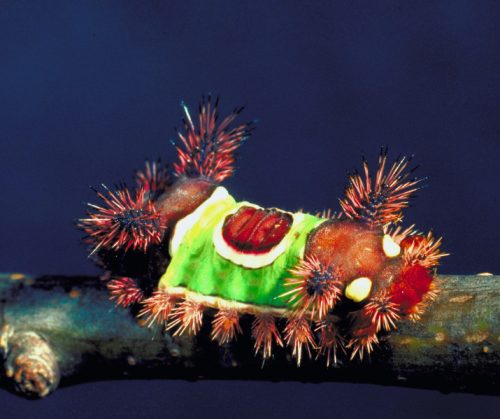
It is the scariest horned caterpillar due to its creepy appearance. It is also termed the most toxic caterpillar since it can give nasty bites.
Saddleback horned caterpillar has a pair of thick horns on either end. These venomous caterpillars are also covered in hairs that cause skin irritation and nasty rashes.
The horn-like protrusions along the sides of the saddleback are distinctive features for easy identification. The lime-green square on the brown spiky body can also help identify them.
The colored circle on the back is the reason for the name saddle. These larvae feed on the leaves of apples, asters, blueberries, dogwood, citrus, corn, and elms.
Scientific Name |
Acharia stimulea |
Host Plants |
Apple, asters, elms, corns, grapes, and dogwood. |
Identification Features |
Four large spiky horns on the head and tail. |
Elephant Hawk Moth Caterpillar
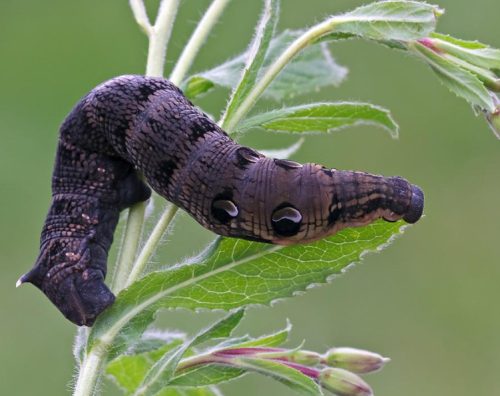
These caterpillars are native to Europe and have a dull appearance due to their brown-gray colors. These grubs can grow up to 7.6cm long.
Some species have dark green bodies with black dots along their sides. The small black or gray spike pointing out at the tail is the distinctive feature.
Elephant hawk moth caterpillars have smooth bodies that make them safe to handle without wearing protective gear.
Scientific Name |
Deilephila elpenor |
Host Plants |
Primrose, willowherb, and grapevine |
Identification Features |
The small curving horn on the tail segment |
Oleander Hawk Moth Caterpillar
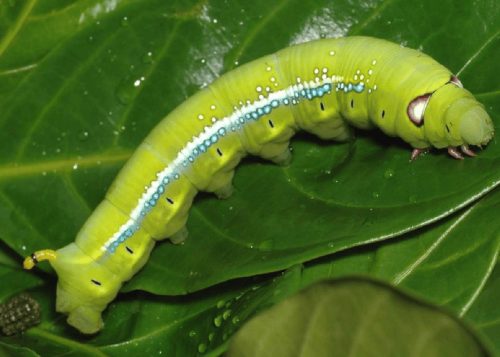
It is a green-horned caterpillar with a voracious appetite for leaves. The spiky horny tail makes these caterpillars resemble tobacco or tomato hornworms.
The eye markings on the head give the oleander hawk caterpillar a menacing look. The fat green slug-like has large prolegs in the middle segments.
The caterpillar also has a pale bluish line running lengthwise on its sides and random bluish dots on the back.
Scientific Name |
Daphnis nerii |
Host Plants |
Oleander plants |
Identification Features |
Small curved pale orange horn at the tail and vibrant blue eye markings on the head. |
White-lined Sphinx Horned Caterpillar
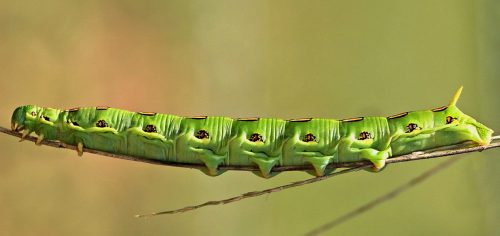
It is a horned green caterpillar with a protruding tail horn. The spiky-looking horn has a yellow band and black tip.
The hairless caterpillar is safe to touch since it does not sting. Some species have smooth bodies with orange dots row.
Other types have lime-green bodies with multicolored dots of yellow, black, and red. I recommend using the four orange prolegs in the middle segment for identification.
Scientific Name |
Hyles lineata |
Host Plants |
Apple, evening primrose, and fuchsia |
Identification Features |
Orange horn on the back and spiky appearance. |
Zebra Longwing Caterpillar with Horns
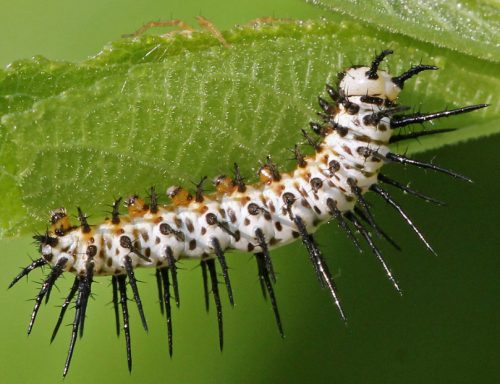
These caterpillars are native to Florida, Texas, and Central America. They have sharp-looking horns sticking out in all directions on their bodies.
Zebra long-wing caterpillars have light-colored gray to white bodies. The six rows of long spines and tiny jagged spikes are the distinctive features.
The black dots all over the body give these caterpillars a menacing look. Refrain from touching these grubs to avoid nasty stings.
Scientific Name |
Heliconius charithonia |
Host Plants |
Passion flowers |
Identification Features |
Light gray or light turquoise green body covered in black sharp-looking horns. |
White-Marked Tussock Furry Horned Caterpillar
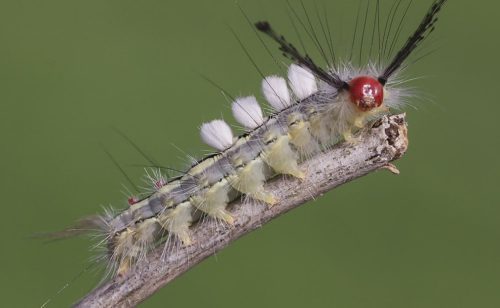
The two large hairy antennae on the front and tail at the end are the distinctive features of white-marked tussock furry horned caterpillars.
The black body and tufts of white hair are other features for identifying the grub. These hairy tufts appear on the back and along the sides.
You can also use the red dots and yellow stripes on the back to make the white-marked tussock furry horned caterpillar stand out from others.
These horned caterpillars are common in North America from Texas and Florida to Alberta in Canada. Refrain from handling these grubs without protective gear.
Scientific Name |
Orgyia leucostigma |
Host Plants |
Birch, cherry, apple, oak, and coniferous trees. |
Identification Features |
Two long hairy horns and hairy tail pointing upward along with white tufts of hair. |
Final Thoughts from Experts
Horned caterpillars are larvae of moths and butterflies. Some types of caterpillars have horns to ward off potential predators. Those caterpillar species with horn-like tails are ideal for wagging to frighten other animals.
Horns are crucial features for identifying different types of horned caterpillars. These caterpillars come in various colors such as green, yellow, black, and more. Other types of caterpillars can be hairy, furry, and striped.
I hope this information helped you learn about various kinds of horned caterpillars in your garden. Feel free to share the article with your friends or family members who find challenges in identifying different caterpillar species.
People Who Read This Also Read:





